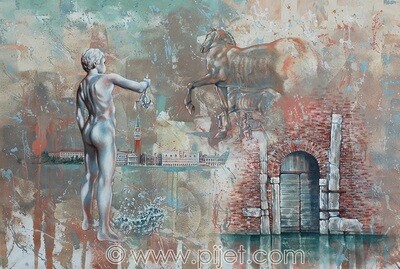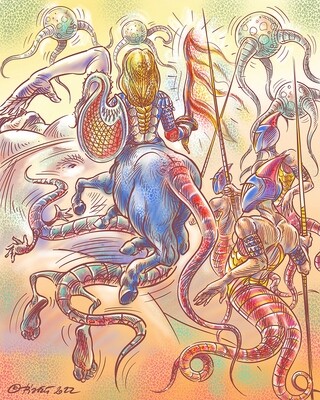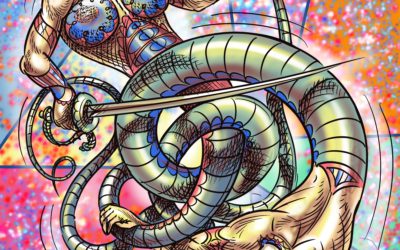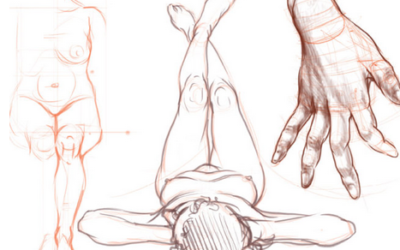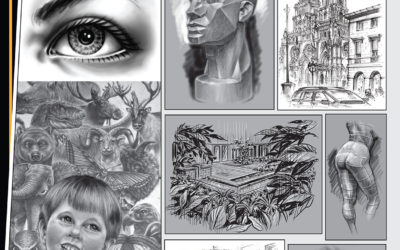The Adoration or Perversity of Childhood in Balthus’s Paintings.
Before the concept of Childhood began to take shape during the sixteenth and seventeenth centuries, the concept of the Child had many symbolic connotations in the popular imagery through the history of art. In a general context, the child symbolizes the new beginning, as for example the New Year, or innocence, naivety and a precious gift. The symbolic meaning of child differed from one culture to the next. In Roman mythology the most famous child besides the traditional founders of Rome, Romulus and Remus, was Cupid, the son and inseparable companion of the Goddess of love, Venus. In Christian iconography, especially in the Renaissance and Baroque periods, children were depicted mostly as flying putto,[1] besides the omnipresent child Jesus. In many other mythologies and rituals of the Near East, Mediterranean, Pre-Columbian, or India and China, the child was an object of offerings generated by barbarian beliefs. Only with the social evolution of societies, especially through the sixteenth to the nineteenth centuries, the importance of elaborated attitude towards the children evolved to the rational social level.
The importance of child as a fundamental element of socio-political regeneration of societies began to be valorized in literature, sculpture, and painting. One of the best descriptions of the importance of the child comes from the William Wordsworth poem “My Heart Leaps Up” in the sentence: “The Child is the father of the Man.” Another great sentence: “The Man is like a river of Childhood,” written by Polish writer Stephan Zeromski, in his book titled “A Story of Sin.” [2] The different psychoanalytical aspects of childhood and adolescence, besides the literature, became more and more visualized in painting and sculpture. Many painters[3] were preoccupied by depiction of different states of childhood.
Balthus was one of the most intriguing painters who depicted mostly feminine childhood in his own particular way. Among other artists who had courage to paint the nude female children in quite provocative poses, as Felicien Rops, Egon Schiele, Otto Dix, or Edvard Munch, Balthus is one of the most mysterious artists. He made his name basically for the intriguing depiction of the female child models. Balthus imagery of young girls oscillates between the adoration and perversity of the childhood. By close dissection of the content of his selected paintings and the elements of their composition as well as the technical aspects of it, we might be able to conclude what generated to such large extend his interest to illustrate the young female bodies the way he did it.
Balthus, whose real name was Balthazar Kossowski de Rola, had Polish origins, but he was born in Paris in 1908. Both his parents were intellectuals and artists.[4] His attraction towards depiction of innocent perversity of the childish female models in their intimately provocative poses was influenced to some extent by the book of Emily Bronte[5] “Wuthering Heights.” Balthus illustrated the first part of the book not because he had a contract for it, but because he was overwhelmed with the story itself. He was especially interested in the childhood of Catherine and Heathcliff, the two principal characters of Bronte’s novel. This particular story inspired majority of his artwork. Each of his paintings is fulfilled with a dose of mysterious sexuality of his models, which is present not only in the exquisite composition, but also in the way he applied the paint on it. Some of the Balthus paintings are still shocking to some viewers even today.
The most controversial of his works is the painting titled “The Guitar Lesson” (see fig.1) which was one of his first five works he exposed in the Gallery Pierre in Paris in 1934 during his first solo exposition. The painting scandalized the public and the French media showed no mercy. He was generally accused of being obsessed with sexual perversity. One of the strongest statements came from Gaston Poulin[6] who named the artist a fanatic nymphomaniac. Furthermore, he described his style as naïve and crude portraying Balthus as the cruelest painter than Goya and Rouault. This particular painting is rarely shown and at the present it is in the hands of a privet collector. Whenever it was exposed, even the first time, it was presented mostly in separate rooms covered with the curtains just for “special” public to see. For forty years Balthus did not wanted this painting to be exposed or printed because as he himself explained from fear of the public misunderstanding of his controversial piece. The close examination of this particular artwork might vaguely respond why would people be offended to such degree by this image. Certainly, it would not be exaggeration to say that this image represents the zenith of his provocative artistic perversity. Many artists are trying to surround themselves with the mist of mystery in order to attract the public interest in their creative efforts[7] and Balthus was a master of it. He never gives any explanation why he does what he does. That is why so much curiosity surrounds him. To criticize his artwork by the imagery would be too easy and unfortunately many critics do it. Before judging his paintings positively or negatively one needs to focus on deeper study of his artwork because in Balthus case each element of the image tells a story, understanding of which depends on how far we are prepared intellectually to dissect the hidden meanings. “The Guitar Lesson” depicts the moment of sadistic violence executed on the innocent female child by her guitar teacher. The child is lying on the teacher’s knees in the position of Pieta[8] suggesting the death Jesus reincarnated in the girl’s denuded figure. The naked body of the child is smoothly transferred symbolically into the erotic guitar on which the teacher is playing the sadistic notes of erotic education. It looks like the child is forced to play hesitantly with the partially denuded sensually erected breast of the teacher. Looking at the Balthus study sketches done for this painting, it becomes clear that he wanted to paint himself as a teacher but probably he realized that such scene would not be acceptable for any public display. It would be too personal and too revealing of his somehow overloaded with sexual fantasies mind. That is why he decided to replace himself with a woman. It probably appeared to Balthus safer to depict lesbian sodomy rather than to use the mixed genders. However, he could not refuse himself the pleasure to portray at least his face in the corps of the woman teacher. Comparing the teacher’s facial futures with the Heathcliff face from “The Cathy’s Toilet,” (see. fig.2) artwork where Balthus portrayed himself as a Heathcliff and his future wife[9] as a Cathy, the two principal characters of his favor book “Wuthering Heights,” the resemblance of the two faces is unquestionable. Furthermore, his sketches (see fig. 3) for the artwork clearly confirm that. The teacher’s right hand is squeezing the girl’s hair lock as the guitar neck and with her left hand she is pulling the imaginary strings in the child’s pubic area. The almost feinted girl gives impression of being entirely submitted to her teacher’s erotic game. Her face projects evident signs of the total subjection to the sadistic sexual sodomy of her innocence. The child’s right hand partly reposing on the floor is touching the guitar neck lying on the parquet forming a triangle suggesting the pubic area. The instrument noise hole is symbolizing the loss of innocence by the girl. The colors[10] of the child’s clothing are also symbols of the transition from the state of innocence to the state of impurity of experienced sexual pleasures. The vertical lines on the wallpaper suggest the cage of immorality to which each female child will eventually be subjected. The green color of the lines symbolizes the freshness of the girl’s femininity. The piano situated on the left side of the painting suggests much more elaborated erotic initiation in the near future when the girl would be a woman.[11] It is really fascinating artwork executed with simplicity and sincere adoration of innocent purity of the childish femininity. This painting is mentioned in many publications as a legendary probably because of its provocative content. Balthus will never again be so open to expose his explicit interiority to the exterior world. This artwork forces us to recognize that we all have a room for provocative drastic perversity and only by pure hypocritical social attitude some of us find paintings like this drastically shocking.
After his questionable experiences with “The Guitar Lesson” painting Balthus elaborated his provocative attitude by painting the adoration of childish femininity using rather poetic eroticism. The best example of such approach would be the artwork titled “Dreaming Therese” (see fig.4). It is beautifully painted canvas. The female child is presented as a dreaming girl. What her dreams might be about we can guess only by her provocatively astride legs exposing in evidence her white panties covering her genital area leaving the space for sensual imagination. Balthus plays with colors to symbolize the content of the picture. The panties are white as well as the half-slip suggesting the unspoiled yet purity. The red skirt surrounds the covered crotch suggesting the future fortress of sexual desires. The red slippers with the black pompons symbolize the approaching sexual enlightenment and the consequences of it. The green colors of the pillow, which make her comfortable, signify the feminine freshness, fertility, and the beauty of the female youth. In the front at the right low corner Balthus placed white cat[12] sipping milk from the white plate. Cat has very rich symbolic meanings but in reference to this picture it symbolizes a protection against demonic forces, perversity, independence, sexual potency, female pubic hairs and in some cultures vagina.[13] The fact that the white cat is licking the rounded white plate suggests the girl’s eroticism of the dreamed dreams. At the same time it suggests the imaginary consumption of the innocence and virginity of the pubescent female child. Balthus is the foreteller of the girl’s intimate future. In the further background he uses again the wallpaper stripes. This time they are red symbolizing again the cage of the future impurity and with the furniture, drapery and pots, the girls unavoidable households destiny. The provocative posture of the model Balthus would use many times in his other compositions. He knew that by such pose he would seduce the viewer’s erotic fantasist imaginary without the necessity to show a young innocent flesh. His mathematically calculated provocative creations would become the trademark of his artistic quest.
During the fifties and the beginning of sixties, Balthus adopted another seductive pose for the models of his sensual compositions. The painting titled “The Golden Age” (see fig.5) is the first from the series of many and as discovered by the scholar Jorg Zutter the first one ever exposed by Balthus in the museum.[14] The artwork shows a young girl stretched comfortably on a small sofa and she is preoccupied by looking at the reflection of herself in the white mirror, which she keeps in her left hand. The mirror symbolizes the world, life, femininity, love, and vanity. The pearl necklace on her neck refers to the virginity, health, perfection, and preciousness. The right hand hung down looks as it is suspended in the air. Her torso is partly uncovered suggesting a delicate touch of feminine coquetry. The girl’s legs are spread in provocative invitation of sexual curiosity. Together, the white slippers on her feet, the white mirror and the white pillow behind her head as well as the white bowl on the table completed with the white light projected from the window situated in the back symbolize the innocent purity of the young female beauty. The entire room is divided by the two sources of light. The white light coming from the window on the left is mixed with the red reflections projected by the chimney. Both these lights blend together exactly in the area of the girl’s spread legs suggesting the boundaries between the innocence and the sexual initiation. The sofa itself has a shape of the hiking shoe suggesting that the young beauty is on her way approaching the sexual fire of her first erotic experience. The man on the right is preparing the ground for her erotic enlightenment by warming up the room. On the left side of the chimney, a small statue with phallic forms is standing. Just beside the sculpture the log tongs are leaning against the chimney surface. The log tongs have the shape of female crotch as well as the form of infant what symbolize the process of future maternity. The chimney itself suggests the female sexual organs and the small in posture man working hard to keep the fire on representing symbolically the process of sexual intercourse. The man with his right hand covered with the white glow is touching the chimney that suggests clearly the act of defloration. The massive quantities of symbolic information, which is easily readable after close examination of all elements of the painting, refer to the passage of time from the childhood to the adolescence and the first encounter with sexuality. It is another great artwork opened to sensual discoveries. Balthus’s mind could be read through the imagery of his paintings. He is proposing the internal conversation and to hear it one needs to understand his symbolic alphabet. His paintings need to be decoded by the meaning of each element. It can take hours or days before one can complete the entire source of information he offers for intellectual digestion on the surfaces of his canvases. To some people his paintings look simple, primitive, or perverse, but only the ignorance can judge his artwork paranoid and obsessive. Balthus came from intelligent and intellectual family and he expressed himself with intelligence too.
Another of Balthus painting titled “The Patience” (see fig.6) reaffirms his genius of writing stories with symbolic images. This artwork is different from the others. Balthus tells the story of a female that is still a child waiting for her sexual enlightenment. The erotic curiosity is already implanted in her soul. She is placing the cards on the pink table trying to foresee when it would happen. The way she placed the cards suggests a window. It is situated between the shadows projected by the girl’s arms on the table suggesting the girl’s spread legs. The candle on the table refers to the phallus. Furthermore, the candle in the chandelier suggests the sexual intercourse. The girl stretched out her legs, one of which is using the support of the chair and the other is on the floor. The curved posture of her body is emphasized by the sensual provocative curve of her buttock. Her face and a part of her body are in the shadow suggesting her innocence and sexual ignorance. The part of the chair is entering between the legs of the table illustrating the process of sexual initiation. The cat under the shadow of the table symbolizes the inexperience of her sexual organs relates to her virginity. Furthermore, the scene of running cat trying to catch the ball suggests the foreplay before the act of the final seduction. The white wall behind with the horizontal division might suggest a bed.
While most of the time Balthus depicted denuded innocence of the childish girls one cannot consider his paintings in anyway as pornographic. The perversity of his images might be disturbing to some only when he painted the models naked with spread legs, this definitely emphasizes the suggestively provocative reading of the picture, as for example in his two chosen artworks for review: first titled “Elevation” (see fig.7) and second titled “Naked and the Guitar” (see fig.6). The “Elevation” was executed in the late eighties. In the square format of the canvas, Balthus painted a child girl touching with the tips of her fingers a toy bird, as she would like to help the bird to fly. Her connection with the toy bird suggests the desire to fly with her innocent mind to satisfy her erotic curiosity. The girl’s spread legs and the half sitting position on the bed with white pillow behind, and sheets, and blankets symbolizes the purity of the sitter waiting for a discoveries of the erotic pleasure. The hungry fixed eyes of the cat, which is coming out from the cage of sexual desires suggest clearly cat’s appetite to catch the bird. The cat might not realize that the bird-versus-girl is not comestible because of her young age. The cat is overwhelmed with the girl’s purity, which makes its appetite for her innocence even greater. The “Naked and the Guitar” was executed in the early nineties. In addition to the even more pronounced and provocative of the girl’s spread legs in this painting, Balthus placed just beside her a guitar as he did it previously in his other paintings. The guitars and cats are very often used in his compositions to emphasize the elaborated erotic content that has to be discovered. Balthus certainly knew that most people even the art critics would judge his artwork by the most evident imagery without seeing the entire story of his paintings. That is why he probably had a lot of fun when he was reading the critics of his works. The scene of this painting is situated in the closed room, probably somewhere in the south, as the window would suggest, maybe even in the Mediterranean. Just by suggesting the Mediterranean region through the window he refers to love and sexual freedom. The girl lying stretched comfortably on the bed marks the center of the painting with her pubic area very evidently saying all what the artwork is about. Her beautiful innocence is offered to the viewer to enjoy looking at her without even being interrupted. The triangle created between her legs, her pubic area and the white blanket refers to the ancient symbol of femininity and erotic poesy and music. The draperies hanged over on the right side of the bed have a form of monk clothing what would suggest the chastity. Furthermore, the violet color of the drapery symbolizes the innocence, virtues, love and beauty but also a short grief and the male genitals in the Indian culture. The composition of the violet drapery by itself is very suggestive. Taking in consideration the omnipresent symbolism in Balthus’s paintings, one has to recognize his artistic genius. Furthermore, each of his artworks has qualities of the sensual novel.
Most scholars recognized the particularity of the subjects of his artistic quest and also his artistic greatness and individuality, while others see rather just the obsessive pedophiliac character and mediocrity of it. His artwork is certainly controversial according to the contemporary social fragility towards such delicate issues as a depiction of the sexual innocence of the children, especially young girls.
However, by careful studies of Balthus works, one can certainly appreciate their thematic and artistic values. In order to have an understanding of his greatness, one needs to see at least one original artwork of his, because Balthus really painted his paintings. By close examination of the surfaces of his canvases one can see his enormous physical effort to produce the three dimensional chromatic coatings. From far away it seems as it is just a flat application of few colors participating in visualization of his images but from a close range by tracing his brush movements, one can feel the excitement he went through in order to get the results he wanted to get. It would not be exaggeration to tell that he struggled with the canvas as he was fighting to exteriorize his adoration and his creative excitement, which was supplied to his mind by the beautiful, fulfilled with innocence childish femininities of the posing models. His seemingly simple paintings have extremely complex exterior chromatic superficies. Whatever excitement he accumulated in his creative mind he throws it out in the chunks of paint with multiple chromatic strokes of his brush. The surface of his canvases besides the figurative content consists of the orgy of the colors applied with the painter’s erotic energy constantly nourished with the adoration of the visual references. The artist devoured the beauty of the innocent bodies with the paint and his brush, and as it can be seen on the surface of his canvases he enjoyed every inch of doing it. Balthus qualities as a painter do not exclude a question, if his artwork is about admiration or perversity of the female childhood. Answer to this question lies somewhere between the two groups of Contemporary society: the paranoid conservative hypocritical part and the mentally healthy and liberated intellectually individuals.
Balthus was one of those artists whose persona had extremely rich inner world filled up with elaborated perverse fantasy. He would not be able to commit any indecent act on the child in reality. His artistic perversity did not materialize in any physical wrongdoing, except on his paintings. He nourished his artistic intellectually degenerative mind with the images of beautiful, young and vulnerable souls. To the certain degree he was a perfect pedophile, one of those who just imagine and keep his dreams in closed room of his mind. The only exteriorization of his lusty thoughts was executed through the genius of his brush. The society would not persecute such pedophiles and certainly the world would be much safer if there would be just Balthuses around. Fantasizing and dreaming do not hurt anyone as long as their fantasies and dreams stay in the closed room of their minds.
To conclude, in the Balthus case to give the clear answer how to perceive his greatly painted artwork is not easy because the line between the adoration and perversion in his phenomenon is extremely thin. However, taking in consideration his inoffensive character it would be honest to say that his dissection of the female childhood was more about the adoration and the dichotomy of it than perversity. Furthermore, his obsessive adoration of the sublime erotic beauty of the unspoiled mentally and physically corpuses served him to provoke the attention to his artwork.
Through his art he was trying to prolong the memories of his own childhood and all his childish erotic fantasies. Balthus knew that each of us has hidden room of perversity locked in our minds against any intrusion of the socio-hypocritical order and with his art he would nourish the hunger of these rooms with his provocative imagery. At the end, art is at its best when it provokes our senses.
[3] Some of the most interesting are Caravaggio, John Singleton Copley, Sir Lawrence Alma-Tadema, Renoir, Sully, John Singer Sargent, William Adolph Bouguereau, Thomas Gainsborough, Peale, Wilson, Butler, Van Honthorst, Ingres, Bonington, Millais, Daumier, Gustave Courbet.
[4] His father Erich Klossowski was the art historian who wrote, besides other books, the Monograph of Daumier. His mother Elisabeth Dorotea Spiro, known as Baladine Klossowska was a painter. Both parents and close family frequented the cultural elites of Paris.
[7] Contemporary example would be Freud, who likes to paint naked, or Bacon, who never cleans his studio. Feminist artists as Schneemann or Judy Chicago funded their own way to get the public attention to their creative conquests.
[8] It is suggested that the XVth century painting “La Pieta De Villeneuve-les-Avignon” painted inspired Balthus by Enguerrand Quarton. Scholar Sabine Rewald suggested that Balthus adopted the Pieta position of the girl to avenge the destruction of his mural painting from the Beatenberg church authorities in 1927.
[10] Red: love, energy, excitement, sin, sacrifice. White: innocence, purity, initiation, the summary of all colors. Black: evil, harm, wrong, immorality, destruction, death.
[11] Balthus was using as a model for this painting the daughter of the janitor from the poor neighborhood. The girl was not comfortable to pose half naked but it was a possibility for her mother to gain little more money. The mother was all the time present when Balthus was sketching her daughter.
[12] Balthus was a great lover of cats, in his Chalet Swiss a Rossiniere he had uncountable amount of cats. When fourteen years old he published a book “Mitsou, forty images by Baltusz,” for which Rainer Maria Rilke wrote introduction, in the same time it was his first text written in French.
Bibliography.
Christian Delacampagne. Balthus 1908-2001. Editions Circle d’Art, Paris, France, 2002.
Claude Roy. Balthus. Editions Gallimard, Paris, France, 1996.
Costanzo Constantini. Balthus a Contr-Courant. Les Editions Noir sur Blanc, Suisse, 2001.
Cristina Carrillo de Albornoz. Balthus. Editions Assouline, Paris, France, 2000.
Etierme Fouilloux. Récupérer Balthus. Vingtième Siècle. Revue d’histoire, No. 3 (Jul., 1984), pp. 119-124
Francois Rouan. Balthus ou son ombre. Editions Galilee, France, Paris, 2001.
Fred S. Kleiner & Christin J. Mamiya. Gardner’s Art through the Ages, the Western Perspective. Thomson Wadsworth, USA, 2006.
Gerard Durozoi. Dictionaire de L’Art Moderne et Contemporain. Editions Hazan, 1992, 1993, 2002.
Gilles Neret. Balthasar Klossowski de Rola Balthus 1908-2001. Taschen GmbH, Koln, Germany, 2005.
Harold Osborne. The Oxford Compagnon to Art. Oxford University Press, 1970.
James Thrall Soby. “Balthus.” The Bulletin of the Museum of Modern Art, Vol. 24, No. 3, Balthus (1956 – 1957), pp. 3-9+11-15+17-20+22-36
Jean Claire. Balthus. Flammarion, Paris, France, 2001.
Jean Laymarie. Balthus. Editions d”Art Albert Skira. Geneve, Swiss, 1982.
Jorg Zutter. Balthus. Editions d’Art Albert Skira, Geneve, et Musee Des Beaux Arts, Lausanne, Swiss, 1993.
Karl Ruhrberg, Manfred Schneckenburger, Christian Fricke, Klaus Honnef. L’Art au XX siecle. Taschen GmbH, Koln, 2005.
Lewis Biggs. Reviewed work(s): Balthus by Jean Leymarie The Burlington Magazine, Vol. 122, No. 925 (Apr., 1980), pp. 270-273
Philip Rylands. Review: “Balthus.” Venice. The Burlington Magazine , Vol. 143, No. 1185 (Dec., 2001), pp. 782-784.
Richard Shone. Balthus and Other Exhibitions. Paris. The Burlington Magazine, Vol. 126, No. 971, Special Issue Devoted to Twentieth-Century Art (Feb., 1984), pp. 117- 116.
Sabine Rewald. Balthus’s Thérèses. Metropolitan Museum Journal , Vol. 33, (1998), pp. 305-314.
Sabine Rewald. Balthus’s Magic Mountain. The Burlington Magazine, Vol. 139, No. 1134 (Sep., 1997), pp. 622-628.
Semir Zeki. Balthus ou La Quete de l’Essentiel. Les Belles Lettres, Paris, France, 1995.
Stanislas Klossowski de Rola. Balthus. Thames & Hudson Ltd, London, 1996.
Susan Felleman. Dirty Pictures, Mud Lust, and Abject Desire: Myths of Origin and the Cinematic Object. Film Quarterly, Vol. 55, No. 1 (Autumn, 2001), pp. 27-40.
Terry Barrett. “Modernism and Postmodernism: An Overview with Art Examples” in Art Education: Content and Practice in a Postmodern Era. Edited by J. Hutchens & M.
Suggs, Reston, Virginia: National Art Education Association, 1997.

